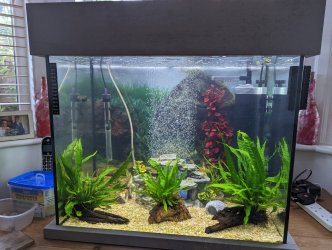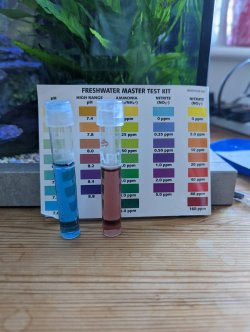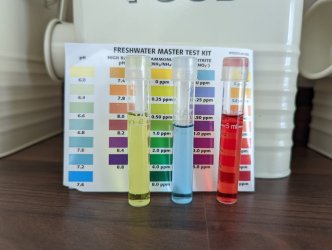Brentstarburst
New Member
Hi,
I've been running a 110 litre tank for a couple months now and for better or worse (bad advice), it went through the Nitrogen Cycle fish in with 5 silver tipped tetras. All survived.
Daily testing with the API master test kit finally proved after 5 weeks, the cycle was completed. SO I added three plants at this stage.
I added 5 more silver tipped Tetras. Water looking lovely and clear.
All being well - a week later I added six corys - 3 x Julii Leopards and 3 x Peru Gold laser stripes and 4 snails to help with the algae.
(on a separate note, the 3 x gold laser are always hiding??)
Since then, there has been a constant haze for several weeks- nothing as bad as a bacterial bloom, but a slight haze which shows more at the rear. I am changing out about 35 litres every other week and I have gently rinsed out the filter in tank water (plus re-arranged the filtration to mechanical, biological and chemical) on a separate occasion. It uses an Aqua One Moray 700 filter.
I tried replacing the course sponge with a combination of course/medium/fine sponge, but this doesn't seem to have made any difference.
The parameters today look okay (see attached)
PH - 8-8.2
Ammonia 0.25
Nitrite - 0
Nitrate - 20-40ppm
The pictures I attach show the slight 'haze' in the back of the tank and I've included pictures of my other tank which is perfectly clear.
Anyone got any ideas? what I might have done or doing wrong?
I've been running a 110 litre tank for a couple months now and for better or worse (bad advice), it went through the Nitrogen Cycle fish in with 5 silver tipped tetras. All survived.
Daily testing with the API master test kit finally proved after 5 weeks, the cycle was completed. SO I added three plants at this stage.
I added 5 more silver tipped Tetras. Water looking lovely and clear.
All being well - a week later I added six corys - 3 x Julii Leopards and 3 x Peru Gold laser stripes and 4 snails to help with the algae.
(on a separate note, the 3 x gold laser are always hiding??)
Since then, there has been a constant haze for several weeks- nothing as bad as a bacterial bloom, but a slight haze which shows more at the rear. I am changing out about 35 litres every other week and I have gently rinsed out the filter in tank water (plus re-arranged the filtration to mechanical, biological and chemical) on a separate occasion. It uses an Aqua One Moray 700 filter.
I tried replacing the course sponge with a combination of course/medium/fine sponge, but this doesn't seem to have made any difference.
The parameters today look okay (see attached)
PH - 8-8.2
Ammonia 0.25
Nitrite - 0
Nitrate - 20-40ppm
The pictures I attach show the slight 'haze' in the back of the tank and I've included pictures of my other tank which is perfectly clear.
Anyone got any ideas? what I might have done or doing wrong?





